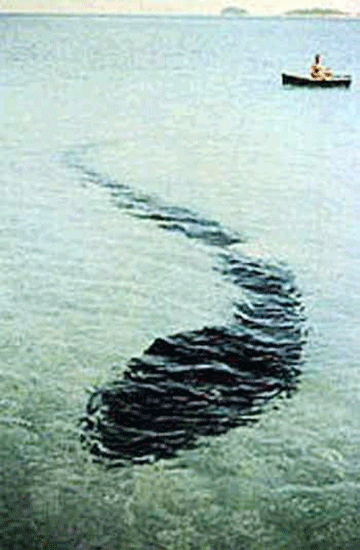
Volume XVII, Issue 22 # May 28 - June 3, 2009 |
 |
|
|
Chessie, Where Are You?
 |
| The typical Chessie report starts off, “We weren’t drinking …” then relates basically the same thing: a creature as long as a telephone pole, head the size and shape of a football, dark tan to olive green and docile. |
27 years ago, Chessie made her one and only movie
movie
Animate but unidentifiable object.
–George Zug, chairman of the Smithsonian Institution’s
Department of Vertebrate Zoology, in response
to questions concerning a purported sea creature
videotaped off Love Point on Memorial Day, 1982
Those four words were all the ultimate voice on creatures of the brine would say on the hottest Chesapeake Bay issue of the time, which was not rockfish, crabs, oysters or aquatic vegetation but a mysterious sea creature nicknamed Chessie. Chessie had popped up at various scattered locations in both the Maryland and Virginia Bay for many months — and would continue to do so for many more months.
It was bizarre. Here we were in modern times, yet untold numbers of Bay watchers were fascinated by reports that would total more than a hundred before Chessie sightings ceased crossing my desk at the now-defunct Evening Sun. I was in the midst of it all, and not by choice —though tracking Chessie was undoubtedly the assignment on which I had the most fun in more than 60 years of newspapering.
It was by luck that Chessie came my way. I happened to answer the phone when Trudy Guthrie of Stevensville called to report the curious creature she and her husband had sighted while boating in the Eastern Bay complex. Scattered reports of mysterious Bay creatures had started to circulate, mostly from watermen whose sightings had come at a distance. The Guthrie sightings were up close, close enough that Trudy was able to sketch what she had seen.
I wrote the story with her sketches and a recap of other previous sightings. It was the biggest newspaper report yet on the creature, and it had credibility: Trudy was the daughter of Dr. Reginald Truitt, who is still referred to as the father of Chesapeake Bay science.
Within a month, more than 30 letters came to my desk describing what were thought to be Chessie sightings: some only from days before; others up to several years previous and untold publicly for fear of ridicule. At the time, Nessie — the Loch Ness Monster — was continuing to make an occasional splash in the media, and from Lake Champlain between Vermont and New York came news of a resident monster nicknamed Champie. Sufficient credence was given Champie’s existence that the Vermont legislature passed a bill to protect her from trophy seekers. (A later and like bill to protect Chessie was laughed off the stage by Maryland lawmakers.)
Chessie on Film
Then just before dusk on Memorial Day 1982, Charlotte Rosier saw something that made everyone forget about the food at Bob and Karen Frew’s cookout at Love Point just north of the Bay Bridge on the other side of the Chesapeake. About 100 feet offshore was something big in the calm waters. It wasn’t a sea turtle, harbor seal, sea otter, school of fish, log or anything else they could imagine.
It was moving up the Bay at a leisurely pace. Binoculars didn’t help in identification. Then Karen thought of the zoom telephoto lens on their video camera. Bob turned on the camera, and by the time Chessie had gone 200 feet he had two minutes of footage, which later was played on local television to make the Bay’s sea serpent famous well beyond the Chesapeake.
As Chessie was moving too far away to show on the camera, those ashore became concerned about a group of five unsuspecting swimmers in the path of the serpent but too far away to hear their warnings. Chessie kept on course, periodically diving and resurfacing. When it reached the swimmers, it sank beneath them — then showed up on the other side of them before disappearing in the distance and the fading light.
Chessie’s 15 Minutes of Fame
When the Frew tape was played on WJZ, scores more Bay users sent letters describing their Chessie experiences. None had photos to offer a hint on Chessie’s identity. So stunned were observers that if they had cameras, they never thought to use them.
To this day, the Frew tape is the only authentic photo known, and it is so fuzzy that even with an Applied Physics Lab computer-generated image the scientists at the Smithsonian could not speculate. Thus, their animate but unidentifiable object answer to queries.
But that was enough; reputable scientists had not trashed the idea of a sea serpent in the Chesapeake as had been predicted. It was animate and it was unidentifiable. T-shirts appeared with sea serpents, freelancers were talking of writing a book (to my knowledge none ever did), Chessie jokes made the rounds, a Baltimore restaurant named a room in her honor as did some skippers their boats. Everyone on the Bay speculated what Chessie might be.
The typical report starts off We weren’t drinking … then relates basically the same thing: a living creature as long as a telephone pole, head the size (maybe a bit bigger) and shape of a football, dark tan to olive green in color. Docile: It shows no aggression yet is not shy of boats, though it keeps its distance. If it thinks things are getting too close, it submerges and is gone. Curiously, not one communication mentions eyes, though a few describe holes in the head where eyes should be.
For about six years Chessie stayed in the news. Then reports abruptly stopped. The headline of the City Paper dated June 21-July 1, 1993, read Chessie’s Dead. No proof, just speculation.
All of this came to mind the other day when I spoke of Chessie; the others in the group, mostly in their 20s and 30s, let their jaws drop. They had never heard of Chessie.
Can it be that one the Bay’s one-time top attractions and fodder for folklore for as long as the Chesapeake is wet is soon to be forgotten? What a shame. Myth or real, Chessie has a role in the lore of the Bay. Methinks she was legitimate.
Enough said.
